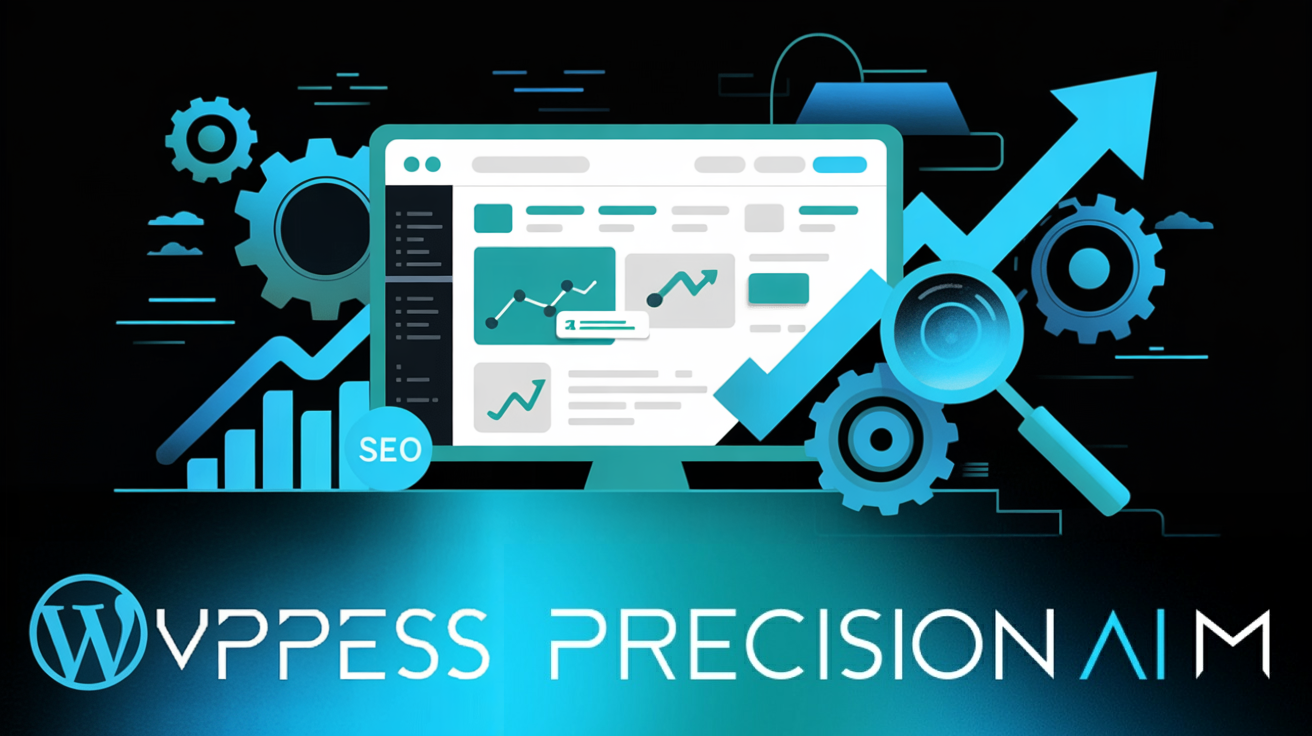Getting your blog noticed isn’t just about writing great posts—it’s about making sure people can actually find them. If you’ve ever wondered why some blogs attract steady streams of readers while others barely register, you’re not alone.
I’ve seen firsthand how blog SEO can turn a quiet site into a traffic magnet. By focusing on the right strategies—like pillar pages, internal links, and smart keyword use—you can build authority and grow your audience without relying on paid ads.
In this guide, I’ll break down what makes blog SEO unique, why it matters, and how you can apply proven tactics for lasting results. You’ll get practical advice on on-page, off-page, and technical optimisation, plus tips for writing posts that both readers and search engines love.
We’ll also cover common mistakes, the latest automation tools, and advanced strategies for scaling your efforts efficiently. By the end, you’ll know exactly how to optimise your blog for sustainable growth and real authority.
What is Blogseo?
Definition and Scope of Blog SEO
Blog SEO is a specialised branch of search engine optimisation focused on raising the visibility and rankings of blogs. Unlike broad SEO, which applies to all website content, blog SEO looks at the unique qualities of content that’s published regularly—think articles organised by date or topic and kept fresh with updates.
So, what really sets blog SEO apart? A handful of features shape its approach:
- Pillar Pages
Hub articles anchor a central theme, linking to focused posts and helping build topic authority. - Interlinked Posts
Linking related articles improves navigation and helps search engines interpret site structure and content relationships. - Categories and Tags
Labelling posts by topic supports easy browsing and clearer indexing. - Publication and Update Dates
Transparent dates assure users and search engines of content freshness and relevance. - Author Profiles and Bylines
Clear author info boosts trust and meets Google’s standards for expertise and authority.
To be treated as a ‘blog’ for SEO, a section should publish articles regularly, organise content with categories or tags, highlight when each post went live or was updated, and display clear author or editorial information. Unlike mostly static website sections—rarely changed and centred on transactions or key details—a blog stays dynamic, updated for topical interest and relevance.
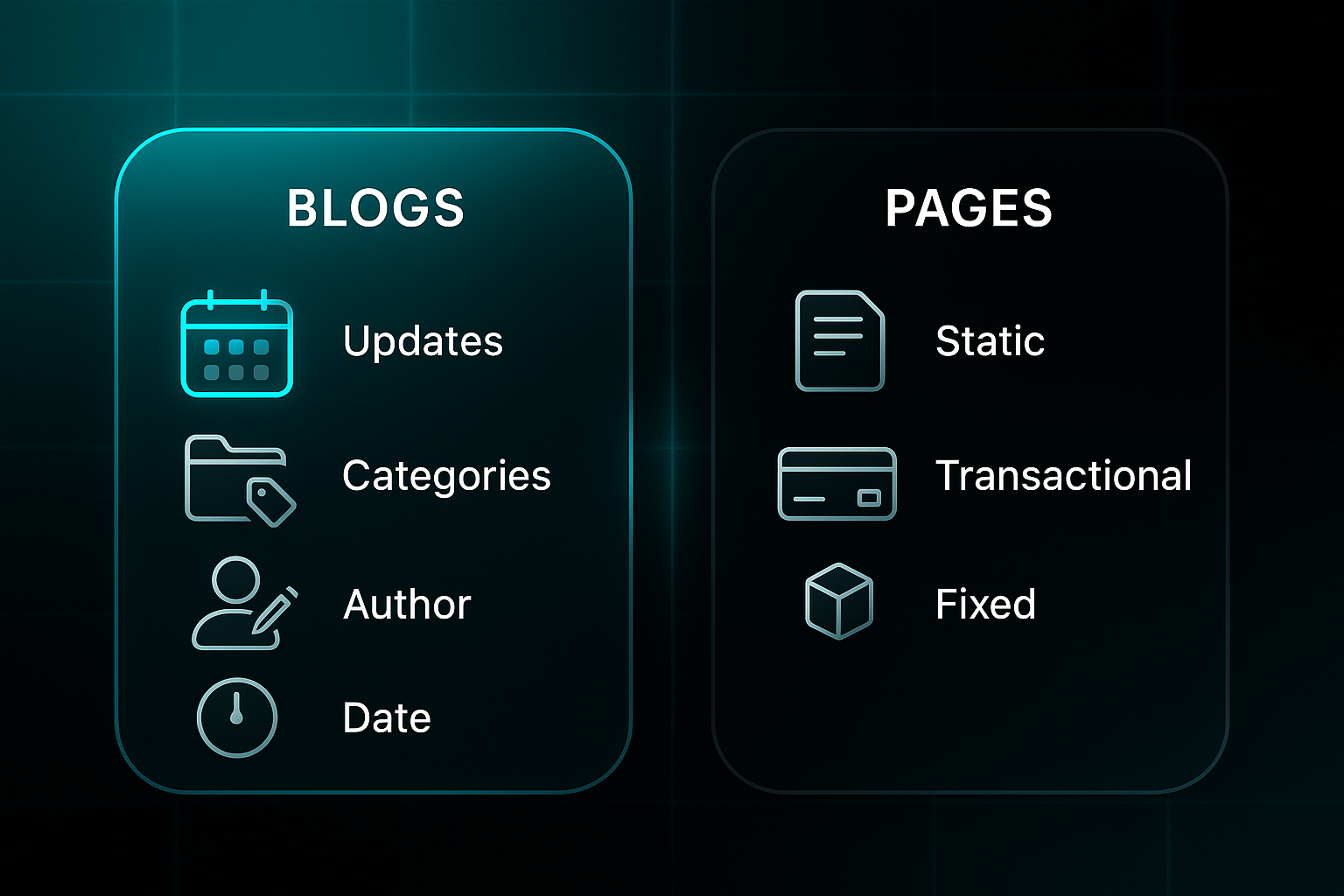
Blog SEO’s Purpose
What’s the main goal here? It’s all about growing your organic audience, widening your site’s reach, and building authority in specific topics. An active blog boosts site search presence, since every new post targets valuable keywords and can earn inbound links—key ingredients for strong SEO.
Publishing high-quality, trustworthy posts signals credibility to both readers and search engines. Features such as author profiles, fresh content, and topic organisation contribute to Google’s E-E-A-T benchmarks, making your blog more reliable.
By focusing on E-E-A-T, which stands for Expertise, Authoritativeness, and Trustworthiness, in your content marketing, you can attract more organic traffic.
Blogs stand out in how they engage audiences. Well-written articles attract people seeking answers at every stage of their journey, from initial research to decision time. By answering questions and sharing practical advice, a blog not only wins loyalty but also introduces readers to the services or solutions that might suit their needs.
Frequent updates, a focus on long-tail keywords, smart internal links, dynamic categories, and transparent authorship all help blogs outperform static web pages. With these strategies, blog SEO contributes to ongoing organic growth and fosters trust, setting the stage for a loyal audience—maybe even new customers.
Why is blog SEO so important?
Blog SEO’s Core Value: Sustainable Growth and Authority
Here’s the thing—blog SEO is your foundation for sustainable, compounding traffic. Unlike ads, which demand ongoing spend, SEO lets you keep reaping rewards from yesterday’s effort.
Right now, organic search drives 53% of all website visits. That’s a bigger share than paid traffic or social media, showing just how powerful great content can be.
Combined, organic (53.3%) and paid search (15%) are responsible for 68% of all trackable website traffic, demonstrating the overwhelming importance of search engines in the digital landscape.
Take HubSpot: their inbound marketing legacy began with a well-optimised blog. Cleanvoice, CommandBar, and Storylane have all pulled in thousands of users through smart guides and long-tail keywords.
Each optimised post strengthens your authority and increases your site’s chance of ranking for valuable search terms. The effect snowballs as your library grows.
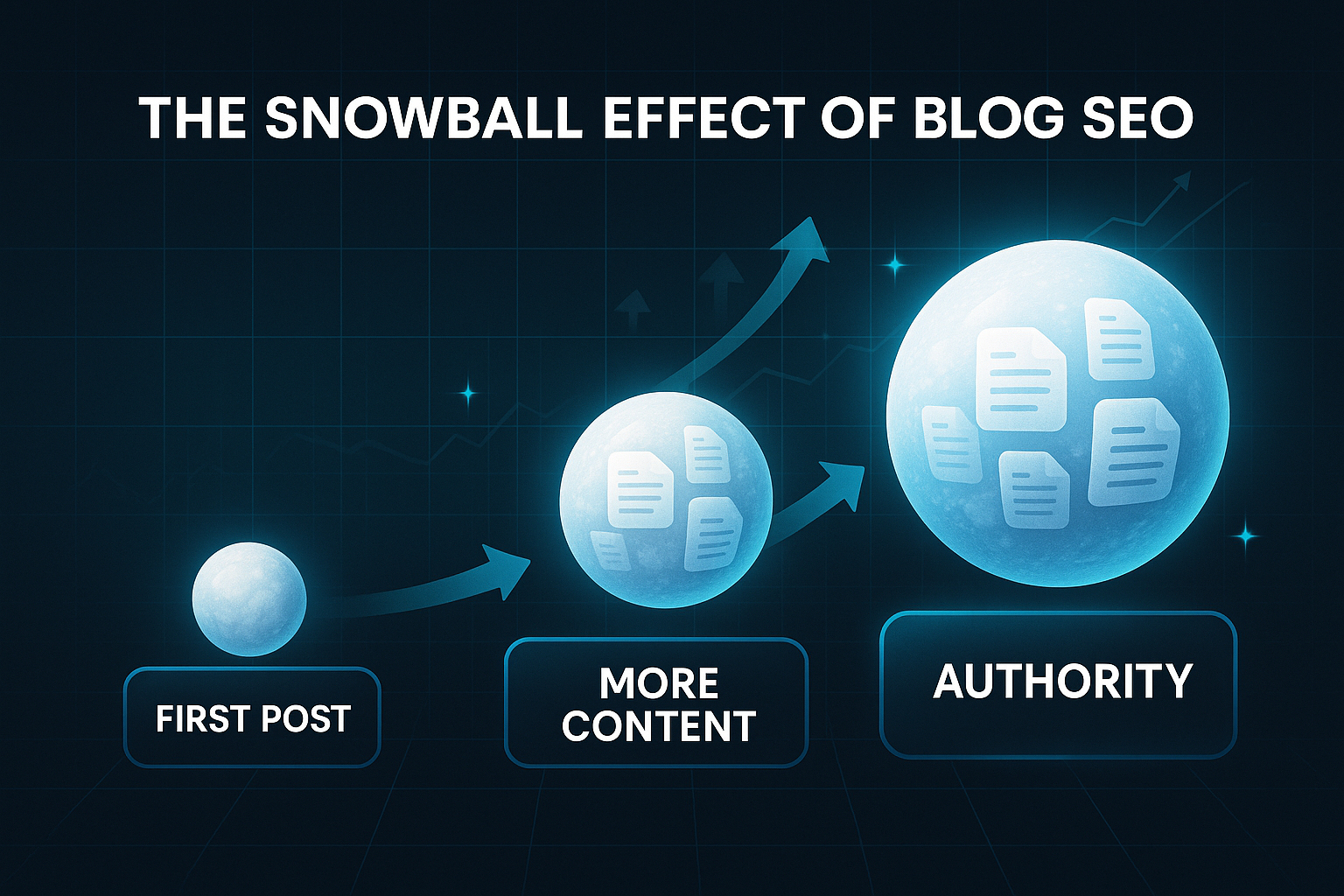
SEO or Paid Ads? Breaking Down the Value
So why choose SEO over ads? Paid campaigns offer quick wins but vanish instantly once the budget slows.
Compare that to blog SEO: invest effort in a post, and it can attract visitors for months—or even years. In some sectors, a paid click can cost over £2, often for just a single fleeting visit.
Blog SEO, on the other hand, transforms that same investment into thousands of visits. Plus, users tend to trust organic search results far more than ads—building not just traffic, but credibility.
Blog SEO in Action: Nathan Liao’s Turnaround
Let’s put a face to this—Nathan Liao at CMA Exam Academy. He started with Google Ads, which worked as long as spending continued. But when budgets tightened, traffic dried up fast.
He switched gears, focusing on educational, search-optimised tutorials around “CMA exam tips”. Gradually, these articles started delivering steady organic leads—no ongoing ad budget required.
The result? A long-lasting resource library that kept bringing in readers and freed up funds for future growth.
That’s the real magic: blog SEO creates lasting growth that keeps delivering, long after you hit publish.
Core elements of blog SEO
On-Page Optimisation
Let’s start with on-page optimisation—the backbone of blog SEO. This is all about making your content easy for both Google and real people to find, understand, and enjoy. Smart on-page tweaks nurture trust and keep your blog relevant.
So, what does effective on-page SEO look like? It means every post is well-structured and genuinely useful—giving it the best shot at ranking and resonating.
- Keyword Research
Target relevant, high-intent terms with tools like SEMrush or Ahrefs. Zapier’s long-tail focus unlocked 800,000+ monthly visits. - Heading Structure (H1, H2, H3)
Use logical, clear headings. HubSpot saw more featured snippets after refining theirs. - Meta Descriptions
Spotlight each post’s benefits. Shopify’s updates boosted CTR by 11%. - Internal Linking
Connect related articles. Backlinko’s pillar approach helped with tough rankings. - Schema Markup
Add FAQ or Article schema for rich results. The New York Times saw 15% more impressions after using schema. - Image Optimisation
Compress and label images; use alt text. Canva’s rankings improved after an image refresh. - Content Readability
Write simply and clearly. NerdWallet’s bounce rate dropped 17% with more readable posts.
Off-Page Optimisation
Of course, SEO isn’t just about your own pages. Off-page efforts amplify your credibility and reach—like digital word of mouth.
- Backlink Building
Gain links with original research or infographics. Ahrefs built authority with focused outreach and great content. - Social Sharing and Content Repurposing
Adapt content for more platforms. Buffer’s traffic rose 25% through strategic sharing. - Guest Posting and Authority Signals
Publish on reputable sites to grow trust. Neil Patel’s guest posts boosted his brand’s presence.
Technical SEO for Blogs
Technical SEO is the engine room—keeping your site fast, accessible, and secure.
- Site Speed and Core Web Vitals
Faster performance led WPBeginner to 20% more visitors. - Mobile Optimisation
Smooth experiences on any device. Medium’s redesign drove more mobile users. - Indexing and Crawlability
Use sitemaps and tags for visibility. The Verge thrived after technical improvements. - HTTPS/Security
Secure sites keep rankings and trust. Wired preserved theirs by migrating to HTTPS.
Together, on-page, off-page and technical SEO form a strong, sustainable framework—driving long-term growth and real authority in your space.
A successful SEO strategy integrates content structure with technical execution, such as using internal linking across topic clusters to improve both site crawlability and user retention.
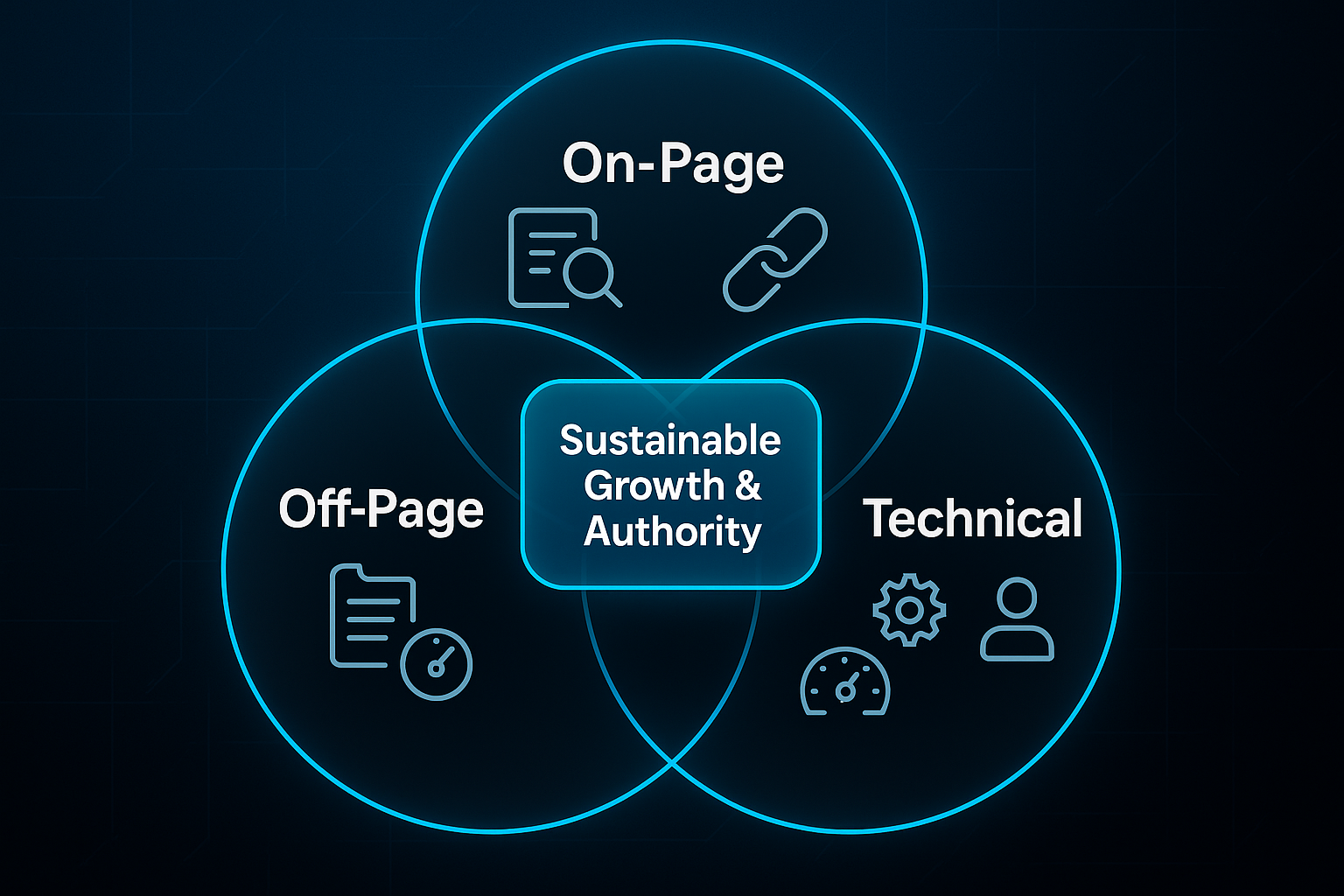
Effective blog post writing and formatting
Creating Engaging, Optimised Posts
What actually draws readers in—and keeps them? It starts with audience-focused topics and a clear sense of value. Rather than guesswork, choose subjects based on what people really search for.
Organising your content with clusters and pillar articles isn’t just tidy—it actually boosts your topical authority and helps users move easily between subjects. These links work a treat for SEO too.
Catchy keyword-driven headlines matter. Place your primary keywords at the front and highlight the benefit so you win attention from both readers and search engines.
A punchy introduction is key. Address what users want right away and promise what’s coming—so people feel compelled to keep reading.
Easy-to-read formatting wins every time. If you use short paragraphs and clear subheadings, even scans over the text will deliver your core message.
And when it’s time for readers to act, clear CTAs should naturally appear where they’re most interested.
Smart internal linking gives readers helpful pathways to your best content, building both engagement and SEO strength.
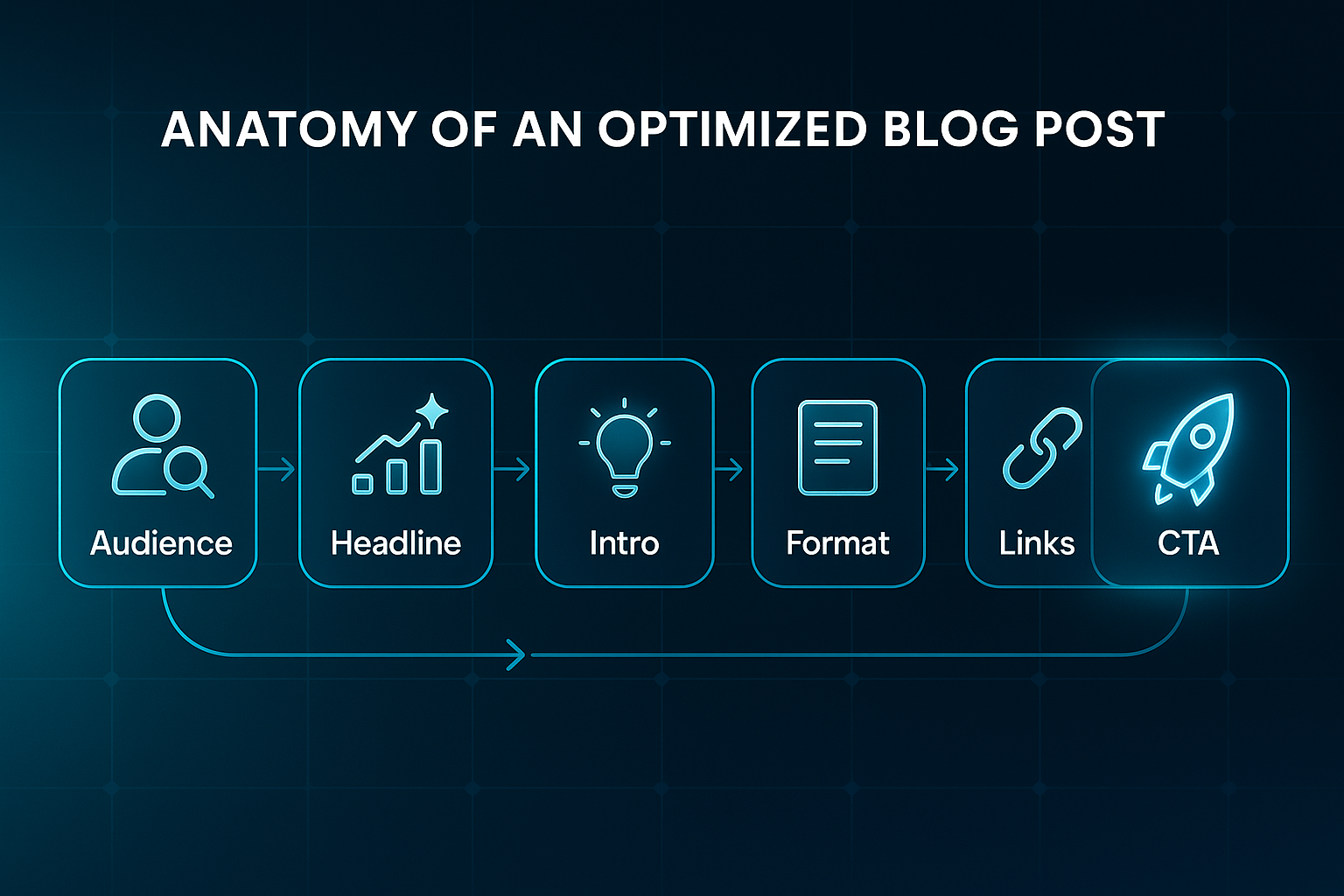
Key Writing Tactics
- Audience-Focused Topics
Choose subjects using audience needs; align content with keyword data for organic traffic. - Content Clusters & Pillars
Link related posts around central themes to establish authority and help users navigate. - Keyword-Driven Headlines
Put main keywords in H1 and highlight value to improve rankings and click-through rates. - Effective Introductions
Open with user intent and a concise preview to hold attention. - Readable Formatting
Use short paragraphs, subheadings, and lists for scanning ease. - Focused CTAs
Add clear, relevant prompts such as “Download checklist” and “Start free trial”. - Smart Internal Linking
Use descriptive anchor text to guide visitors to cornerstone content.
EEAT in Blog Content
When you want to build trust, think EEAT—experience, expertise, authority, and trustworthiness.
EEAT Essentials
- EEAT Fundamentals
Focus on experience, expertise, authority, and trust to boost credibility and Google rankings. - Show Author Expertise
Display relevant experience or unique insights for perceived authority. - Reputable Source Citations
Refer to respected sources to build factual trust. - Transparency & Updates
Show publish dates, bios, and regular content updates. - Natural Content Flow
Write in a helpful, authentic way; avoid keyword stuffing or over-linking. - Technical EEAT Signals
Implement schema, alt text, HTTPS, and include testimonials or case studies if possible.
Pillar and Cluster Structures for Blog SEO
What are Pillar Pages and Content Clusters?
Let’s demystify the pillar and cluster strategy—a staple of modern blog SEO. Picture your pillar page as the main hub: a deep resource on a broad topic.
Your cluster articles branch out, each diving into a key subtopic, always linking back to that central pillar. Together, this creates a tightly connected network.
This isn’t just about neat organisation. Google loves comprehensive, linked content structures. That’s how your site starts building topical authority fast.
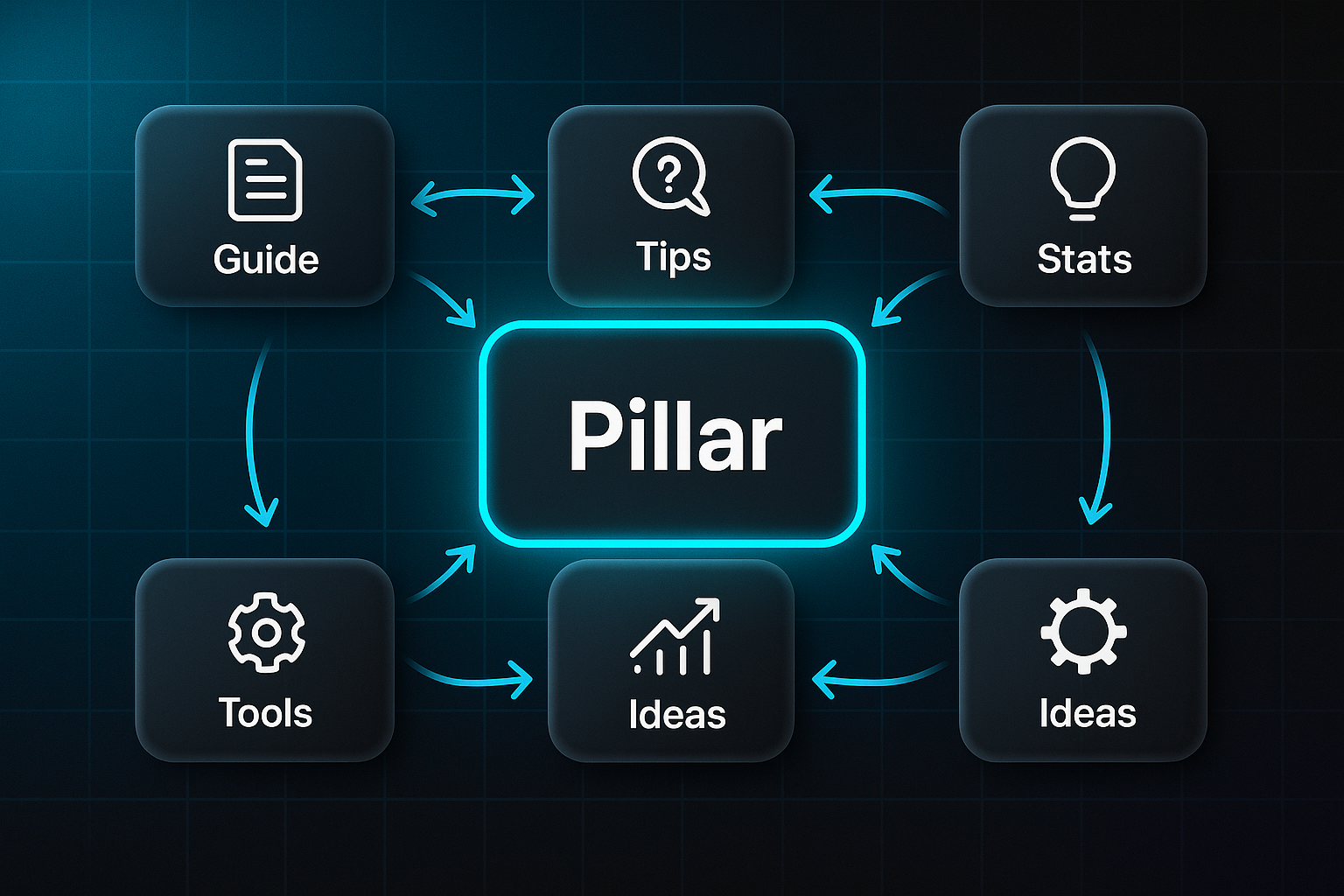
HubSpot’s “marketing automation” pillar page is a standout example. It threads together guides on subtopics like email campaigns and tool comparisons, all interlinked. This structure gives readers context and naturally lifts rankings.
Ultimately, strong connections and thorough coverage help you rank for more keywords, win featured snippets, and keep visitors on your blog far longer.
Building and Expanding Cluster Strategies
Setting up your first pillars is only the beginning. The real value comes from keeping these clusters fresh and responding as your market changes.
Start by mapping out core themes, then brainstorm every related question or need your ideal reader might have. Use tools like Ahrefs or SEMrush to identify and add trending subtopics.
Track your progress: keep an eye on organic traffic and keyword spread across cluster pages. According to Moz and SEMrush research, this method can boost key page visits by up to 30%.
Finally, don’t neglect regular content audits. Repair broken links, update your resources, and always look for gaps. That’s the secret behind a content ecosystem that gets more powerful year after year.
Blog structure, user experience, and engagement signals
Structuring Blog Content and Navigation
A great blog structure does more than tidy things up—it helps both people and search engines find your best content. Blogs with clear categories, neat menus, and hub pages often see organic traffic rise by as much as 30% after restructuring.
Keep your main categories focused, ideally between four and eight, to help everyone quickly grasp what you’re all about. Add subcategories only where they truly clarify what’s inside.
Menus should follow these categories closely, giving straightforward routes to your most valuable content. This sort of hierarchy helps Google crawl your site and nudges readers deeper into related posts. Pillar pages acting as navigation lighthouses bring order and point visitors to key clusters.
Breadcrumb navigation is a small but mighty trick. It gives users a clear sense of direction, lowers bounce rates, and lets your internal links quietly support both humans and search bots.
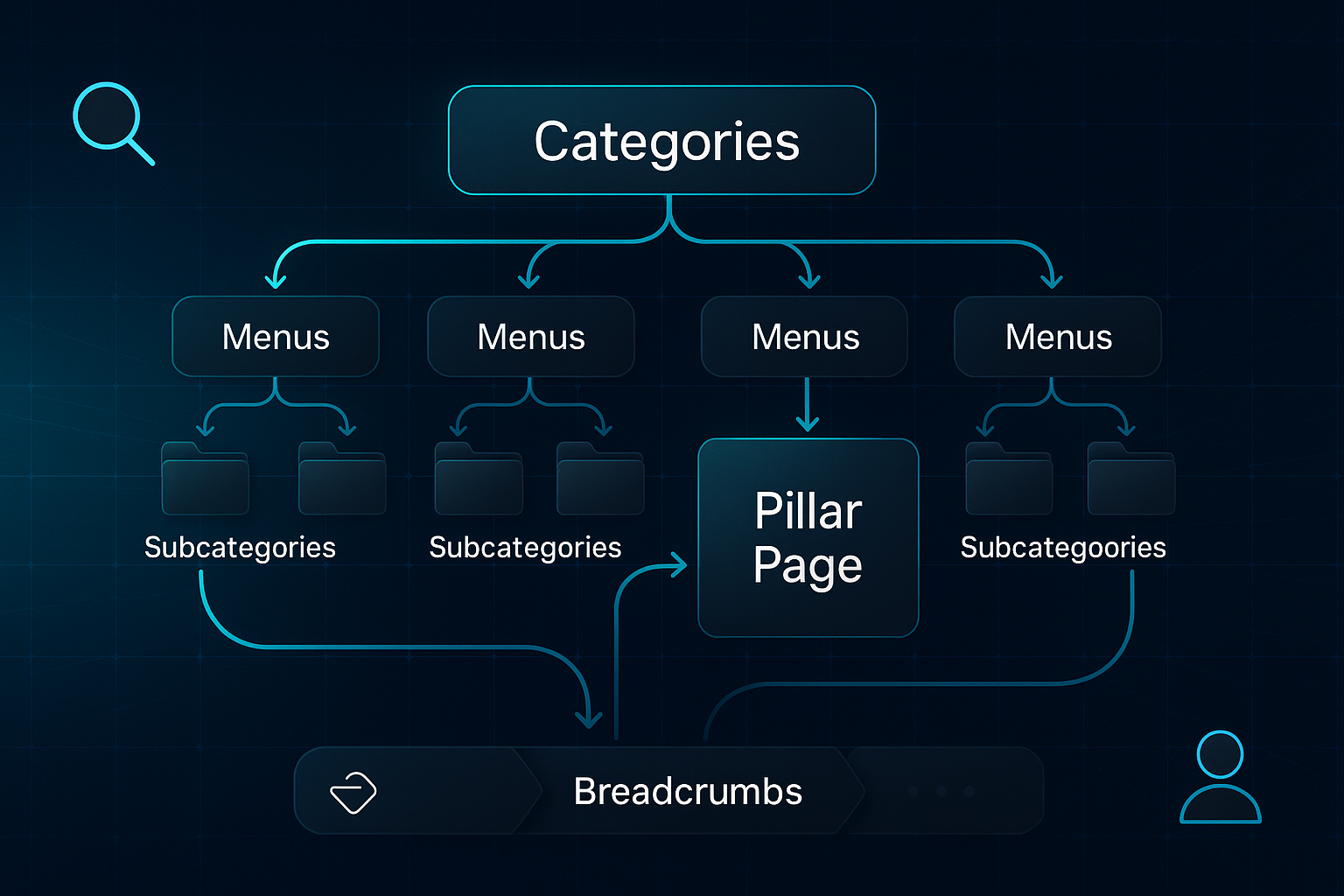
Sidebars and featured sections come into play here too. They highlight trending or timely content, tempting visitors to keep reading—or nudging them towards crucial calls to action.
And here’s the kicker: don’t let your navigation stand still. Keep testing with real users and analytics tools like GA4. Fix any friction you find, and you’ll keep both your readers and Google coming back for more.
Media optimisation for blog SEO
Media is more than just decoration—it’s a genuine boost for your blog’s SEO. With the right optimisation, images and videos do much more than look good; they can strengthen rankings, make content accessible for all, and keep readers engaged longer.
Image Optimisation
So, what truly makes for great image SEO? Descriptive, keyword-strengthened filenames are a must, paired with concise alt text—ideally less than 125 characters. Not only does this tick the accessibility box, but it can lead to 17% more image search impressions.
Speed really matters in this game. Compress your images so they stay under 100KB, and switch to modern formats like WebP or AVIF for quicker loading.
Responsive images via srcset mean your content always looks sharp, no matter the device. JPEG and PNG are still handy for compatibility or transparent backgrounds.
Video and Rich Media Strategies
Embedding videos—especially in pillar or cluster posts—can increase visitor dwell time, clarify core ideas, and support your calls to action. Position them where they naturally support your message.
Always include crisp thumbnails, captions or transcripts, and ARIA labels to support accessibility. Native lazy loading (loading="lazy") keeps load times snappy and bounce rates low, so even mobile users get the best experience.
Link building strategies for blogs
Internal Linking Best Practices
Internal linking is the heartbeat of blog SEO—guiding visitors to your best content and showing search engines how your posts fit together. Aim for 1–2 internal links every 300 words, totalling about 5–10 per post. Use clear, context-rich anchor text so links feel natural, never forced.
Set up pillar and cluster pages using hub-and-spoke structures, supported by neat menus and sidebars. Breadcrumbs might seem simple, but they smooth out navigation and help users find their way.
Regular link audits with tools like Screaming Frog or Ahrefs are a smart move—they help you find orphaned pages that need links. These checks can boost session duration by 18% and indexed pages by 24%.
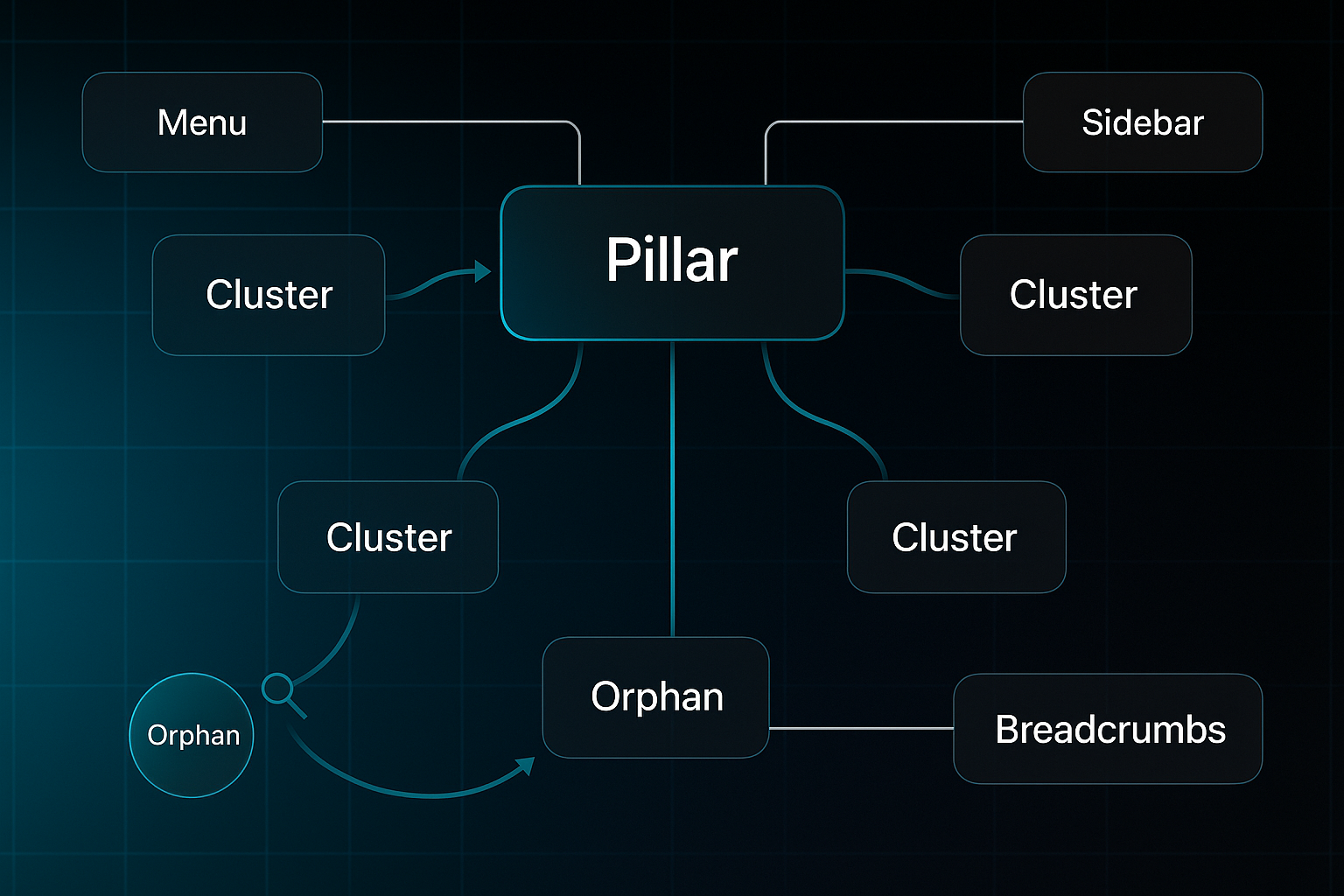
Connecting related subtopics delivers higher search traffic and better crawl rates.
External Linking and Backlink Acquisition
Backlinks from reputable sites act as powerful ranking signals—they’re reputation boosters. Prioritise guest posts and expert features with credible domains. Sixty-five percent of top-linked articles include proprietary research.
Track your backlink profile using SEMrush or Ahrefs, only using Google’s Disavow Tool for proven threats. Reliable outreach and smart management bring sustained authority and ongoing organic growth.
SEO analytics and performance monitoring for blogs
Core SEO Metrics to Track
Tracking the right SEO metrics changes the way your blog grows. Start with organic traffic for a snapshot of search-driven reach and momentum.
Keep an eye on keyword positions. Noticing ranking shifts—whether up or down—shows which topics thrive and where you’re losing ground.
Engagement signals such as click-through rate (CTR), bounce rate, average engagement time, and pages per session reveal how real people interact. Are they sticking around or clicking away?
Don’t overlook your conversion data. Seeing which posts drive action helps you pinpoint the real commercial value of your efforts.
Want even deeper insights? Segment your data. Compare branded and non-branded queries, measure pillar page performance, or track engagement across different clusters. These patterns help you update, expand, or refine internal linking with confidence.
Tools and Ongoing Improvement
No need to guess what’s working—platforms like Google Search Console, GA4, SEMrush, and Ahrefs reveal everything from rankings to technical snags.
Set dashboards and alerts to catch slips, like rapid ranking drops or crawling hiccups. Check reports regularly.
Log what you find, and act—update weaker posts, tweak CTAs, or strengthen topic clusters.
This steady, data-driven routine means your blog is always getting better—driving growth, lasting engagement, and visible results.
Common blog SEO pitfalls and misconceptions
Most Frequent Mistakes
Let’s get right to it—critical SEO mistakes can quietly undermine your blog’s performance. Think keyword stuffing: packing posts with too many keywords only damages readability and trust, and search engines penalise such tactics quickly.
Technical errors are just as disruptive. Problems like duplicate content, missing canonical tags (which tell Google which page version to index), or weak mobile optimisation all make it harder for search engines to find and rank your content.
Content-related slip-ups can be equally harmful. Neglecting content clusters or ignoring E-E-A-T—that’s experience, expertise, authoritativeness, and trustworthiness—weakens your authority and trust with both users and Google. Posts without clear author profiles are especially vulnerable since Google’s recent updates focus on helpful, high-quality content.
The good news? Most issues have simple fixes: use keywords naturally, run regular technical audits, consolidate similar posts, build clusters around topics, and demonstrate your expertise with visible credentials.
Misconceptions
One persistent myth is that blog SEO is “set-and-forget”. In reality, lasting results come from ongoing optimisation. Search algorithms evolve, so failing to update meta tags, titles, or main content sees your hard-won visibility fade away.
Regular technical and content audits, plus routine refreshes, are what keep your posts relevant and audience engaged, no matter how old your blog is.
Key Takeaways for Future-Proof Blog SEO
To future-proof your blog, focus on organic keyword use, technical diligence, topic clustering, and steady optimisation. Monitor analytics, update often, and you’ll keep building on your successes while avoiding nasty surprises.
How automation and AI-driven solutions change the game for blog SEO
Why automation matters for modern blog SEO
Let’s be honest—keeping those blog SEO plates spinning is exhausting. You’re juggling keyword research, fixing technical snags, updating old posts, and watching analytics.
This is where automation makes all the difference. Automated platforms step in, taking care of repetitive jobs—think routine health checks and real-time keyword tracking.
The real impact? You get freedom to focus on bigger-picture strategy and writing standout content.
AI tools expedite content creation by generating ideas, suggesting improvements, and even drafting initial versions. This results in higher-quality, SEO-optimised content that appeals to both users and search engines.
Plus, automation can catch issues and new opportunities instantly—sometimes long before you spot them yourself.
Comparing traditional methods and new capabilities
Manual SEO was a grind: link audits by hand, sprawling spreadsheets, everything slow and frustrating.
Now AI-powered platforms map content clusters in minutes, suggest internal links instantly, and flag posts needing a refresh—no slog required.
You get faster, more reliable improvements.
When Google rewrites the rules, you’re ready to adapt on the fly.
The agency vs. platform approach
Agencies used to own these advantages, but their steep fees held small teams back.
Today’s affordable SaaS platforms deliver advanced automation for a fraction of the price.
This means you keep control, get expert insights, and fine-tune when you wish—all without agency overhead.
Human + AI: the winning formula
Here’s the magic: blend human expertise with automation.
AI takes care of routine, people bring creativity and big-picture thinking.
As a result, together they cover more ground—making your blog SEO sharper and far more effective.

AI-Powered Content Strategy
See the AI platform that's replacing entire content teams (with better results).

Scaling, budget, and efficiency strategies for blog SEO
Efficient Scaling Fundamentals
Scaling blog SEO isn’t about overwhelming yourself—it’s about high-impact actions, smart automation, and getting the balance between cost, quality, and control just right. Small teams or solo bloggers see great ROI by streamlining meta tag updates, strengthening internal links, and using workflow templates.
Here’s the catch: outsourcing can help, but too much automation or generic freelance work risks losing your unique voice. For niche blogs, personality matters.
Real-World Efficiency Example
One food blogger jumped from 2,000 to 12,000 monthly organic visits in 2024 using Leap AI’s £25/month audits and focused freelance editing at £60 per post. Templated workflows plus selective automation cut production time by half—far cheaper than agencies.
Choosing Platforms and Services
- Selection Criteria
It comes down to team size, content needs, budget, technical skill, and how much SEO control you want. - Subscription Automation
Platforms like SEOSwarm and blog-in-one-minute offer quick, quality SEO blog setups for fast scaling. - DIY Manual Tools
Tools like Ubersuggest help hands-on creators stay lean and in control.
Scaling smartly means growth, efficiency, and keeping the flavour that sets your content apart—without blowing your budget.
Blog-in-one-minute
Add a fully SEO-optimised blog to your website with just 2 lines of code.
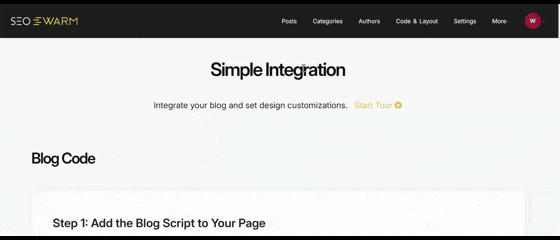
Advanced tactics and emerging trends in blog SEO
Technical Innovations and Evolving Practices
Blog SEO has stepped up, focusing on pillar pages and tightly interlinked clusters. SurferSEO’s case studies reveal 45–70% growth in organic traffic using these strategies.
That hub-and-spoke setup—one comprehensive pillar anchoring cluster posts—turbocharges topical authority and keeps bounce rates low. Many marketing blogs see up to 60% more sessions within six months. Adding clever tables of contents and engaging multimedia boosts results even further.
Schema markup has become critical for rich results and AI-friendly visibility. Entity, FAQ, and author schemas now matter most. Automated deployments with tools like WordLift keep your schema up to date; The New York Times saw a 27% increase in SGE citations by updating regularly.
To keep rankings resilient, stay agile as Google changes with semantic search, passage indexing, and Core Web Vitals—concise headings and technical audits are key.
Real-World Applications for Diverse Users
Solo bloggers rely on AI-driven tools to group keywords and automate links. Using Search Atlas and Semrush, creators report 20–40% more organic sessions by quickly building smart clusters.
Platforms like MarketMuse and Clearscope help agencies trim audit and publishing time by 35%, driving both authority and search visibility.
My Final Thoughts on BlogSEO Success
Most blogs fade into obscurity because their SEO is an afterthought, not a system. The truth is, sustainable growth comes from treating blog SEO as an ongoing discipline—one that blends technical precision, audience insight, and regular optimisation.
If you’re serious about results, here’s what I recommend: - Map out pillar and cluster topics to build authority - Audit your technical setup for speed, mobile, and crawlability - Use automation for routine tasks, but keep your unique voice front and center - Track analytics weekly, update old posts, and fix internal links
Blog SEO isn’t a one-time fix—it’s a living process that rewards consistency and curiosity. The blogs that win are those that adapt, measure, and improve with every post. Treat your blog like an asset, not an afterthought, and you’ll see compounding returns long after you hit publish.
- Wil







